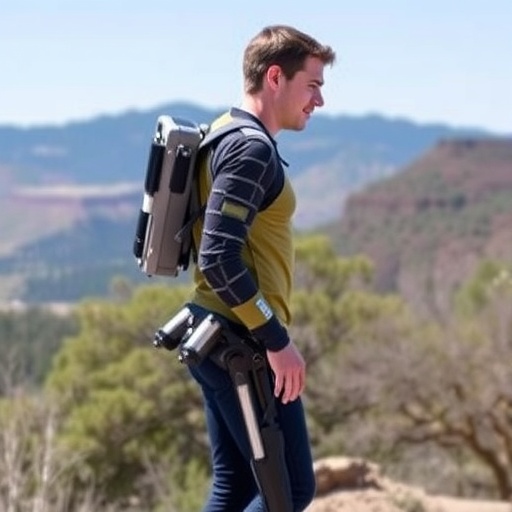Imagine a future where individuals with physical disabilities can regain the ability to walk independently, powered by advanced robotic exoskeletons. This vision is becoming more tangible thanks to a transformative initiative from Northern Arizona University (NAU), which is spearheading the development of an open-source robotic exoskeleton framework known as OpenExo. This system represents a significant breakthrough in the field of biomechanics and rehabilitation robotics, aiming to democratize access to cutting-edge technology.
Currently, the process of designing and manufacturing robotic exoskeletons involves substantial financial investment and extensive research efforts. Such complexities often discourage new researchers from exploring the potential of exoskeleton technology. However, with years of pioneering work from NAU’s Biomechatronics Lab, led by associate professor Zach Lerner, OpenExo marks a milestone that seeks to dismantle these barriers. By providing an open-source framework, the project makes it possible for developers and researchers to build on existing knowledge and innovations, rather than starting from scratch.
The functionality and efficacy of an exoskeleton hinge on its biomechanical compatibility with the human body. Thus, substantial testing and individual customization are paramount for each device. The intricate interplay of moving parts, along with various technologies and interdependent systems, necessitates a multi-disciplinary approach that encompasses engineering, computer science, and physiological science. OpenExo stands out by offering a comprehensive, user-friendly guide that synthesizes years of research into a singular resource that can be easily accessed and understood by budding engineers and scientists.
.adsslot_hlf7wkErAC{ width:728px !important; height:90px !important; }
@media (max-width:1199px) { .adsslot_hlf7wkErAC{ width:468px !important; height:60px !important; } }
@media (max-width:767px) { .adsslot_hlf7wkErAC{ width:320px !important; height:50px !important; } }
ADVERTISEMENT
The inception of OpenExo was detailed in a recent publication in the journal Science Robotics. This open-source system is not merely theoretical; it encompasses detailed instructions for building both single-joint and multi-joint exoskeletons. Included in this resource are design files, code repositories, and meticulous step-by-step guides aimed at empowering a global community of innovators engaged in the rehabilitation and mobility augmentation sectors.
The significance of OpenExo extends beyond technical specifications. Lerner emphasizes that this project plays a pivotal role within the broader research community, particularly during times of dwindling federal grant funding. Accessibility to open-source platforms like OpenExo is becoming increasingly vital, enabling a continuous exchange of knowledge and facilitating innovation in areas that directly impact quality of life for individuals with disabilities.
Lerner and his team have already made a meaningful difference with their work, contributing to the rehabilitation of children with cerebral palsy and assisting patients with various gait disorders. Their research is founded on practical applications and has attracted millions of dollars in grants, while also leading to the creation of a spin-off company that successfully brought a robotic ankle device to market. Their achievements highlight the potential commercialization of technology developed through academic research, illustrating how innovation flows from theory to tangible benefits for society.
With the launch of OpenExo, Lerner aspires to reinvigorate research in the field by providing a framework that encourages collaboration and knowledge-sharing among researchers. He articulates a profound sense of fulfillment when discussing the potential for exoskeletons to empower individuals with mobility impairments. The emotional weight of such advancements underscores the essence of what technology should strive to accomplish: meaningful contributions to human well-being.
The first-author of the publication, postdoctoral scholar Jack Williams, alongside a team of dedicated researchers, presents findings that signal a new era in biomechatronics. This collaborative effort not only includes graduates of NAU but also emphasizes the importance of cross-institutional partnerships in advancing the frontiers of technology. By pooling expertise and resources, these innovators are collectively poised to tackle the challenges associated with exoskeleton design and implementation.
Financial support for this groundbreaking work has been provided through private donations and federal funding, illustrating the diverse funding landscape crucial for advancing scientific research. Not only have private benefactors recognized the potential of Lerner’s work, but support from the National Institutes of Health and the National Science Foundation underscores a wider institutional acknowledgment of the importance of accessible rehabilitation technologies. This collaborative funding approach reflects a growing recognition of the multifaceted benefits of rehabilitation robotics.
As Lerner envisions the future of research in this area, he remains optimistic that OpenExo will catalyze new explorations and innovative solutions. The modular design concept allows for adaptability, encouraging researchers to iterate on existing designs while meeting the unique needs of various users. With an open-source framework, the complex nature of exoskeleton technology becomes a shared challenge, inviting collective problem-solving and knowledge exchange within the global research community.
The development and deployment of robotic exoskeletons could transform the landscape of mobility assistance. By enhancing user experience, reducing dependency on caregivers, and promoting independence, exoskeletons symbolize a significant stride toward inclusivity for individuals with mobility challenges. Lerner’s team is poised to usher in new possibilities that could redefine what is achievable for those affected by disabilities.
In summary, the OpenExo initiative is more than a technical achievement; it is a heartfelt commitment to enhancing lives. By fostering open-source collaboration, this project has the potential to revolutionize the field of rehabilitation robotics and enable individuals with disabilities to reclaim their mobility and autonomy. The confluence of technology and compassion in this groundbreaking venture exemplifies the truly transformative power of innovation.
Subject of Research: Robotic exoskeletons for mobility augmentation
Article Title: OpenExo: An Open-Source Modular Exoskeleton to Augment Human Function
News Publication Date: 25-Jun-2025
Web References: Science Robotics
References: N/A
Image Credits: N/A
Keywords
Robotic exoskeleton, open-source, rehabilitation, biomechanics, mobility assistance, democratization of technology, engineering, disability empowerment.
Tags: advancing mobility for disabled individualsassistive technology for disabilitiesbiomechanics and rehabilitation innovationcollaborative robotics research initiativescustomizable exoskeleton designsdemocratizing exoskeleton accessfuture of walking assistance technologymulti-disciplinary approach in roboticsNAU biomechanics researchopen-source robotic exoskeletonOpenExo project developmentrehabilitation robotics technology





